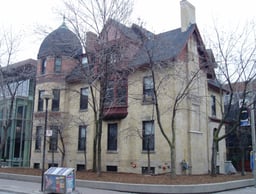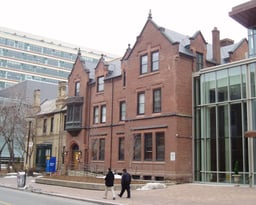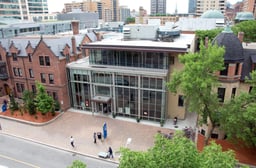Ryerson University

Ryerson University

Former names | Ryerson Institute of Technology, Ryerson Polytechnical Institute, Ryerson Polytechnic University | ||||||
|---|---|---|---|---|---|---|---|
| Motto | Mente et Artificio | ||||||
Motto in English | With Mind and Skill[1] | ||||||
| Type | public | ||||||
| Established | 1948 | ||||||
| Endowment | C$ 135,788,513 (2017–18)[2] | ||||||
| Chancellor | Janice Fukakusa | ||||||
| President | Mohamed Lachemi [3] | ||||||
| Undergraduates | 39,300[4] | ||||||
| Postgraduates | 2,600[5] | ||||||
| Location | Toronto ,,Canada | ||||||
| Campus | Urban, (121 acres or 49 ha)[6] | ||||||
| Sports team | Ryerson Rams | ||||||
| Colours | |||||||
| Affiliations | AACSB, AUCC, ACU, U Sports, COU, IAU, OUA, ONWiE | ||||||
| Mascot | Eggy the Ram | ||||||
| Website | www.ryerson.ca [94] | ||||||
 | |||||||
| University rankings | |||||||
| Global rankings | |||||||
| ARWU World[72] | 901–1000 | ||||||
| QS World[73] | 801–1000 | ||||||
| Times World[74] | 601–800 | ||||||
| U.S News & World Report Global[75] | 816 | ||||||
| Canadian rankings | |||||||
| ARWU National[72] | 27–28 | ||||||
| QS National[73] | 26 | ||||||
| Times National[74] | 22–28 | ||||||
| U.S News & World Report National[75] | 25 | ||||||
| Maclean's Comprehensive[76] | 11 | ||||||
| Maclean's Reputation[77] | 14 | ||||||
Ryerson University, simply Ryerson or RyeU, is a public research university in Toronto, Ontario, Canada. Its urban campus surrounds the Yonge–Dundas Square, located at one of the busiest intersections in downtown Toronto.
The majority of its buildings are in the blocks northeast of the Yonge-Dundas Square in Toronto's Garden District. Ryerson's business school, Ted Rogers School of Management, is on the southwest end of the Yonge-Dundas Square, located on Bay Street, slightly north of Toronto's Financial District and is attached to the Toronto Eaton Centre. The university has expanded substantially in recent years with new buildings such as the Mattamy Athletic Centre, in the historical Maple Leaf Gardens arena, former home of the Toronto Maple Leafs.[7] The university's administration services are also housed in 1 Dundas and 495 Yonge Street. The university is composed of 39,000+ undergraduate students, 2,600 graduate students, and 12,000 continuing education students.[8][9] Ryerson is ranked 4th in Ontario and 10th in Canada by student enrollment.[10]
Ryerson University is home to Canada's largest undergraduate business school, the Ted Rogers School of Management,[11] and Canada's third largest undergraduate engineering school, the Faculty of Engineering and Architectural Science, as well as the Faculty of Arts, Faculty of Communication & Design, Faculty of Community Services, and the Faculty of Science.
In 2017, the university was approved by the Federation of Law Societies of Canada to begin working towards establishing a social justice and innovation focused law school.[12] The school will mark the third law school in Toronto after York's Osgoode program and University of Toronto's Law degree.
Former names | Ryerson Institute of Technology, Ryerson Polytechnical Institute, Ryerson Polytechnic University | ||||||
|---|---|---|---|---|---|---|---|
| Motto | Mente et Artificio | ||||||
Motto in English | With Mind and Skill[1] | ||||||
| Type | public | ||||||
| Established | 1948 | ||||||
| Endowment | C$ 135,788,513 (2017–18)[2] | ||||||
| Chancellor | Janice Fukakusa | ||||||
| President | Mohamed Lachemi [3] | ||||||
| Undergraduates | 39,300[4] | ||||||
| Postgraduates | 2,600[5] | ||||||
| Location | Toronto ,,Canada | ||||||
| Campus | Urban, (121 acres or 49 ha)[6] | ||||||
| Sports team | Ryerson Rams | ||||||
| Colours | |||||||
| Affiliations | AACSB, AUCC, ACU, U Sports, COU, IAU, OUA, ONWiE | ||||||
| Mascot | Eggy the Ram | ||||||
| Website | www.ryerson.ca [94] | ||||||
 | |||||||
| University rankings | |||||||
| Global rankings | |||||||
| ARWU World[72] | 901–1000 | ||||||
| QS World[73] | 801–1000 | ||||||
| Times World[74] | 601–800 | ||||||
| U.S News & World Report Global[75] | 816 | ||||||
| Canadian rankings | |||||||
| ARWU National[72] | 27–28 | ||||||
| QS National[73] | 26 | ||||||
| Times National[74] | 22–28 | ||||||
| U.S News & World Report National[75] | 25 | ||||||
| Maclean's Comprehensive[76] | 11 | ||||||
| Maclean's Reputation[77] | 14 | ||||||
History
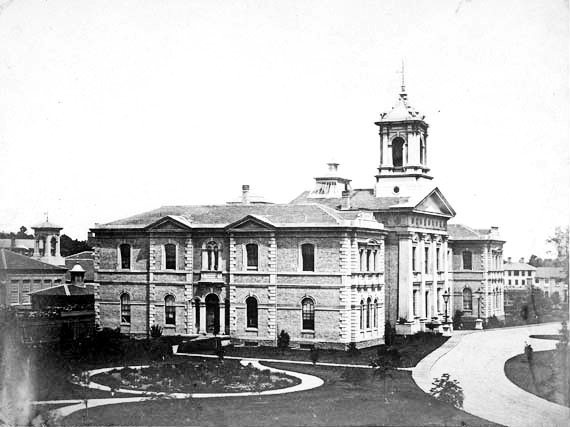
The Normal School on Gould St. 1856

The Normal School in 2008
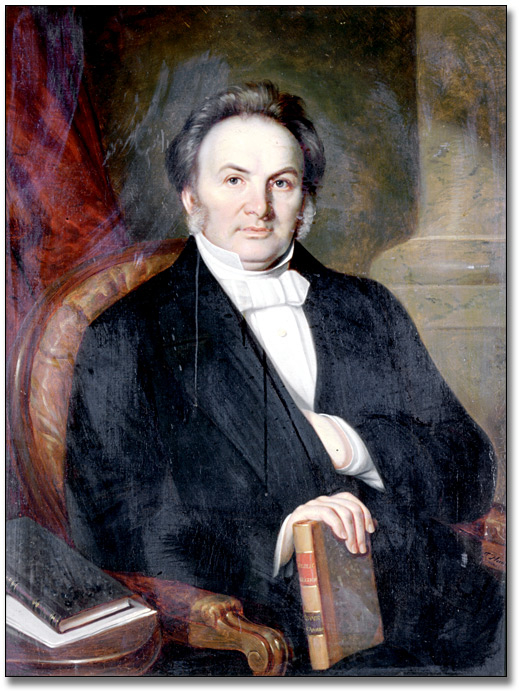
Egerton Ryerson (1803-1882)
The Normal School was founded by Egerton Ryerson in 1847 as the first teacher-training institution in the province. It moved into a new building in 1852, on a parcel of semi-rural land eventually bounded by Gerrard, Victoria, Gould and Church streets.
In 1852, at the core of the present main campus, the historic St. James Square, Egerton Ryerson founded Ontario's first teacher training facility, the Toronto Normal School.[14] It also housed the Department of Education and the Museum of Natural History and Fine Arts, which became the Royal Ontario Museum. An agricultural laboratory on the site led to the founding of the Ontario Agricultural College and the University of Guelph. St. James Square went through various other educational uses before housing a namesake of its original founder.
Egerton Ryerson was a leading educator, politician, and Methodist minister.[15] He is known as the father of Ontario's public school system.[16] He is also a founder of the first publishing company in Canada in 1829, The Methodist Book and Publishing House, which was renamed The Ryerson Press in 1919 and today is part of McGraw-Hill Ryerson, a Canadian publisher of educational and professional books, which still bears Egerton Ryerson's name for its Canadian operations.
Advances in science and technology brought on by World War II, and continued Canadian industrialization, previously interrupted by the Great Depression, created a demand for a more highly trained population. Howard Hillen Kerr was given control of nine Ontario Training and Re-establishment centres to accomplish this. His vision of what these institutions would do was broader than what others were suggesting. In 1943, he visited the Massachusetts Institute of Technology (MIT) and was convinced Canada could develop its own MIT over one hundred years. Along the way, such an institution could respond to the society's needs. When the Province approved the idea of technical institutes in 1946, it proposed to found several. It turned out all but one would be special purpose schools, such as the mining school. Only the Toronto retraining centre, which became the Ryerson Institute of Technology in 1948, would become a multi-program campus, Kerr's future MIT of Canada.[17]
The Toronto Training and Re-establishment Institute was created in 1945 on the former site of the Toronto Normal School at St James Square, bounded by Gerrard, Church, Yonge and Gould. The Gothic-Romanesque building was designed by architects Thomas Ridout and Frederick William Cumberland in 1852.[18] The site had been used as a Royal Canadian Air Force training facility during World War II.[14] The institute was a joint venture of the federal and provincial government to train ex-servicemen and women for re-entry into civilian life.
The Ryerson Institute of Technology was founded in 1948, inheriting the staff and facilities of the Toronto Training and Re-establishment Institute. In 1966, it became the Ryerson Polytechnical Institute.
In 1971, provincial legislation was amended to permit Ryerson to grant university degrees accredited by provincial government legislation and by the Association of Universities and Colleges of Canada (AUCC).[19] That year, it also became a member of the Council of Ontario Universities (COU).[20] In 1992, Ryerson became Toronto's second school of engineering to receive accreditation from the Canadian Engineering Accreditation Board (CEAB).[21] The following year (1993), Ryerson formally became a University, via an Act of the Ontario Legislature.
In 1993, Ryerson received approval to also grant graduate degrees (master's and doctorates). The same year, the Board of Governors changed the institution's name to Ryerson Polytechnic University to reflect a stronger emphasis on research associated with graduate programs and its expansion from being a university offering undergraduate degrees. Students occupied the university's administration offices in March 1997, protesting escalating tuition hikes.[18]
In June 2001, the school assumed its name as Ryerson University. Today, Ryerson University offers programs in aerospace, chemical, civil, mechanical, industrial, electrical, biomedical and computer engineering. The B.Eng biomedical engineering program is the first stand-alone undergraduate biomedical engineering program in Canada. The university is also one of only two Canadian universities to offer a program in aerospace engineering accredited by the Canadian Engineering Accreditation Board (CEAB).
Organization
|
|
|
|
Ted Rogers School of Management
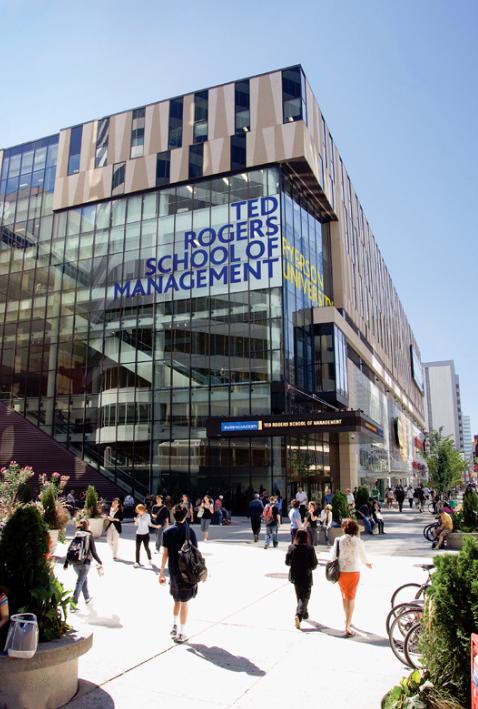
Ted Rogers School of Management
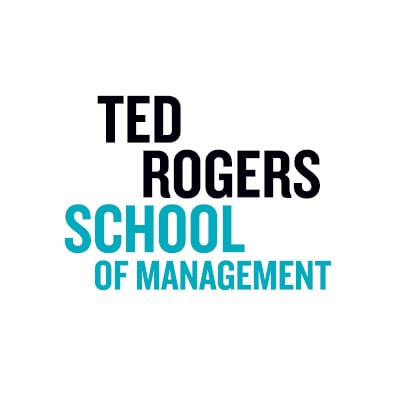
Ted Rogers School of Management logo
The Ted Rogers School of Management (TRSM) is a business school accredited by the Association to Advance Collegiate Schools of Business (AACSB).[22] Located on Bay Street near Toronto's financial district, the TRSM offers various programs in a variety of business disciplines. The school houses Canada's largest undergraduate management program, along with several graduate programs.[23][24][25] The school's undergraduate Bachelor of Commerce (BComm) programs are grouped into:
Accounting & Finance
Business Management
Business Technology Management
Hospitality & Tourism Management
Retail Management
The Ted Rogers School of Management is a recognized leader in entrepreneurship education in Canada and houses the Ryerson University Entrepreneurship Program, one of the largest entrepreneurship programs in Canada.[26]
Graduate studies consist of an MBA with a global focus and an MBA in the Management of Technology and Innovation. The school also offers a research focused Master of Management Science (MScM) in the Management of Technology and Innovation.
The acceptance rate of Ted Rogers School of Management's MBA program is 25%, the second lowest of 39 Canadian MBA programs ranked by Financial Post in March 2012.[27]
In the 2009-2010 academic year, Ryerson introduced two new majors to the Business Management program: Law & Business, and Global Management Studies. The Global Management Studies major is a successor of the Management major, last offered in 2010-2011.[28]
In fall 2013, Ted Rogers School of Management launched a new School of Accounting and Finance. Accounting and Finance majors are exclusively offered through the School of Accounting and Finance and are no longer attainable through the Business Management Program.
The business programs housed on campus in the "Business Building", moved into new facilities after a $15 million donation from Ted Rogers. The school is within a new wing of the Toronto Eaton Centre at the southeast corner of Bay and Dundas Streets. The school occupies three floors of the nine-floor wing (two floors are occupied by retail uses, with an above-grade parking garage occupying the remaining three storeys). The integration of the Ryerson faculty with commercial uses in the same building has been praised as an innovative solution for the downtown university.[29]
The school received national notoriety when one of its professors (James Norrie) insulted the cast of the Dragons' Den during the final negotiations stage of a successful pitch by students of the school. The deal ultimately fell through because of the professor's actions. The same professor was later banned from campus and sued the university.[30]
Faculty of Arts
The Faculty of Arts comprises eleven humanities and social science departments (as of Winter 2018) and plays a unique dual role in the university. The faculty offers:
graduate programs, at both the master's and doctoral levels, that have a strong component of scholarship, research, innovation and critical analysis;
high-quality arts-based education through liberal studies courses that cut across all of Ryerson's degree program curricula, from journalism to engineering to business. Liberal studies challenge students' intellect and imagination, nurturing their ability to think critically and adapt to the accelerating pace of change in today's world.
|
|
|
|
Faculty of Communication & Design
The Faculty of Communication & Design is composed of nine schools, offering a total of 13 undergraduate and seven graduate degrees of major study.[31]
|
|
|
|
Graduate programs include a Ph.D. and MA programs in Communications and Culture (jointly with York University) and master's degrees in documentary media, fashion studies, journalism, media production, photographic preservation and collections management, and professional communications. The faculty also houses a gallery and museum, the Ryerson Image Centre.
Faculty of Community Services
Ryerson's Faculty of Community Services offers multi-disciplinary programs in health, early childhood studies, social justice, and community development. The faculty incorporates health and safety programs under the School of Occupational and Public Health. The School of Occupational and Public Health (SOPHe) is considered a leader in injury and disease prevention education. Ryerson University is the only school that offers a degree program in occupational health and safety in Ontario. Certificate programs in health and safety can be completed through the Chang School of continuing education.
The faculty also includes the Midwifery Education Program (MEP), which celebrated its 20th anniversary in 2013. The Ryerson MEP site is part of the longest-running consortium of its kind in Canada (with sister-sites at Laurentian University and McMaster University).
In keeping with Ryerson's brand of a career-focused education, students partner with various mentors, supervisors, practitioners and professionals to ensure a career-relevant experience is provided, in addition to the theoretical instructions commonly offered in a classroom setting.
The University also hosts a large nursing school named in 2008 for Daphne Cockwell, mother of donor Jack Cockwell and nurse who volunteered to work with veterans returning to South Africa from World War II.[32]
The faculty also includes the School of Urban and Regional Planning. Serving programs in both the undergraduate and graduate level, the undergraduate program is one of two accredited programs in Ontario recognized by the Ontario Professional Planning Institute.
Faculty of Engineering and Architectural Science
The Ryerson Faculty of Engineering and Architectural Science (formerly Faculty of Engineering, Architecture & Science) is one of Canada's largest engineering faculties, with over 4,000 undergraduate students enrolled in 9 bachelor's degree programs (19 when including options/specializations), and over 500 graduate students in 15 master's and 5 doctoral degree programs.[33] Ryerson's Aerospace Computational Laboratory is a node for the High Performance Computational Virtual Laboratory for the Greater Toronto Area. The HPCVL is an interuniversity high-speed computation network which acts as a virtual supercomputer, providing the intensive computation power needed in the solution of complex problems in engineering and other disciplines.
Ryerson University's Department of Architectural Science is housed in a building at 325 Church Street designed by the prominent Canadian architect Ronald Thom (Ryersonian). It offers a program in architecture accredited by the Canadian Architectural Certification Board at the bachelor level (B.Arch.) and the master's level (M.Arch.).[34]
The Centre for Computing and Engineering opened in September 2004 and is a state-of-the-art science, technology, and research facility spanning almost an entire city block in downtown Toronto. The building was renamed the George Vari Engineering and Computing Centre in November 2005. Ryerson researchers in the engineering and science disciplines have earned prestigious Premier's Research Excellence Awards (PREA), Canada Research Chairs, NSERC Industrial Research Chair. A biomedical engineering program started at Ryerson in fall 2008 is the first such program in Canada.
The faculty hosts the Centre for Urban Energy. CUE is co-sponsored by Hydro One, Ontario Power Authority and Toronto Hydro. The centre focuses on energy research and urban energy challenges.
Faculty of Science
On June 29, 2011, the university announced the University Senate approved a Faculty of Science, the newest faculty at Ryerson University in approximately 40 years. The Faculty of Science consists of the four founding departments – Chemistry & Biology, Physics, Mathematics, and Computer Science.[35]
Ryerson University's Faculty of Science offers a Bachelor of Science (BSc) degree in areas of applied mathematics, biology, biomedical science, chemistry, computer science, financial mathematics, and medical physics. Graduate studies consist of areas in biomolecular, biomedical, computational and mathematical studies.
Continuing Education

Heaslip House
The G. Raymond Chang School of Continuing Education is the school responsible for continuing education within Ryerson University. It offers certificate programs, degree credit courses, and certificate and interest courses. It is one of Canada's largest providers of university-based adult education, with over 66,000 annual enrollments in 2016-2017.[9]
The DMZ
The DMZ is a business incubator for startups from Ryerson and around the world. Since its inception in 2010, the DMZ has incubated over 300 startups. It also has a Digital Specialization Programme and a Fellowship programme where skills are imparted.[36] In April 2015, on the 5 year anniversary of the founding of the DMZ, the name was shortened from "Digital Media Zone" to DMZ.[37]
The DMZ at Ryerson is ranked as no. 1 university-based incubator in the world, and no. 1 in North America by UBI Global.[38]
Campus
Ryerson Square
Ryerson's central hub is a pedestrian area that runs along Gould and Victoria Streets, known as Ryerson Square.[39]
In 1978 the public lane known as Victoria Street extending south from Gould was closed to vehicle traffic.[40] The southeasterly corner of at this intersection was a parking lot.[41] This space now forms part of Devonian Square and features a reflecting pond used as a skating rink in the winter.[42][43] Devonian Square is owned by Ryerson but is maintained by the City of Toronto Parks, Forestry and Recreation. The park was designed in 1978 by Toronto landscape architecture firm Richard Strong, Steven Moorhead Ltd. Design and construction of the square was partially funded by the Devonian Group of Charitable Foundations of Calgary — lending the park its name. The space features huge Precambrian igneous and metamorphic rocks that are approximately two billion years old. These were trucked in from the Canadian Shield.[44]
Wanting to expand the pedestrian area, the Ryerson Students' Union (RSU) campaigned for years to close off traffic from Gould Street. In 2010 a one-year pilot program was approved which was later extended by six months.[45] On February 6, 2012, Toronto City Council voted to permanently close the street to car traffic, from O'Keefe Lane to Bond Street.[46] The space was official renamed Ryerson Square. It features seating areas, potted plants and is used for a weekly farmers market, student group sign-up days and festivities associated with Ryerson's week of welcome.[47][48]
Campus expansion
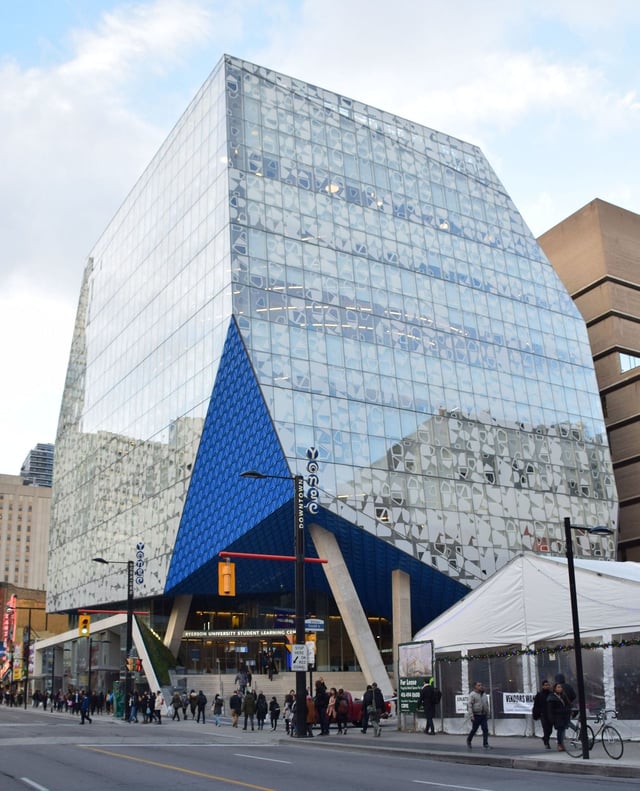
Student Learning Centre, from Yonge Street
In 2006, the university announced a large campus expansion, with the creation of a University Master Plan.[49][50] Over the next 10 years, the university expanded substantially, opening several new buildings including the Student Learning Centre,[51] a new student athletic centre at Maple Leaf Gardens,[7] and a new student residence.[52]
In 2008, three properties on Yonge Street, including the former Sam the Record Man store, were acquired to allow the university to construct a Student Learning Centre.[51][53] Opening in 2015, this Snøhetta designed building provides students a space to study and collaborate - as well as giving Ryerson a face on Yonge Street.[54]
As of fall 2017, Ryerson's next major development, the Daphne Cockwell Health Sciences Complex, is under construction on Church St north of Dundas St East. When complete in Fall 2018, the 29 storey complex will mix academic space, administrative offices, and 18 storeys of accommodation for 332 students.[56]
In 2013, Ryerson acquired two parking lots from Infrastructure Ontario for $32 million to meet future growth. The properties are a 5,400 m2 (58,000 sq ft) lot at 202 Jarvis Street (at Dundas Street) and a 750 m2 (8,100 sq ft) plot at 136 Dundas Street East (and Mutual Street). The two sites will continue as parking lots until the university raises capital funding.[57] In 2019, Ryerson submitted a rezoning application for a 41-storey tower at 202 Jarvis Street, which will include an 11-storey academic base with classrooms, labs, and research space intended for the Faculty of Science, along with a student residence.[58][59]
In 2018, it was announced that in 2022 Ryerson would open a new campus in Brampton, Ontario in partnership with Sheridan College. The new campus would focus on delivering programs in science, technology, engineering, arts and mathematics (STEAM).[60][61][62][63] In April 2018, funding of $90 million was offered by the provincial government for the project.[64][65] On 23 October 2018 however, the new Provincial government (elected in June) withdrew the funding for plans such as this, effectively cancelling the project.[66]
Mattamy Athletic Centre
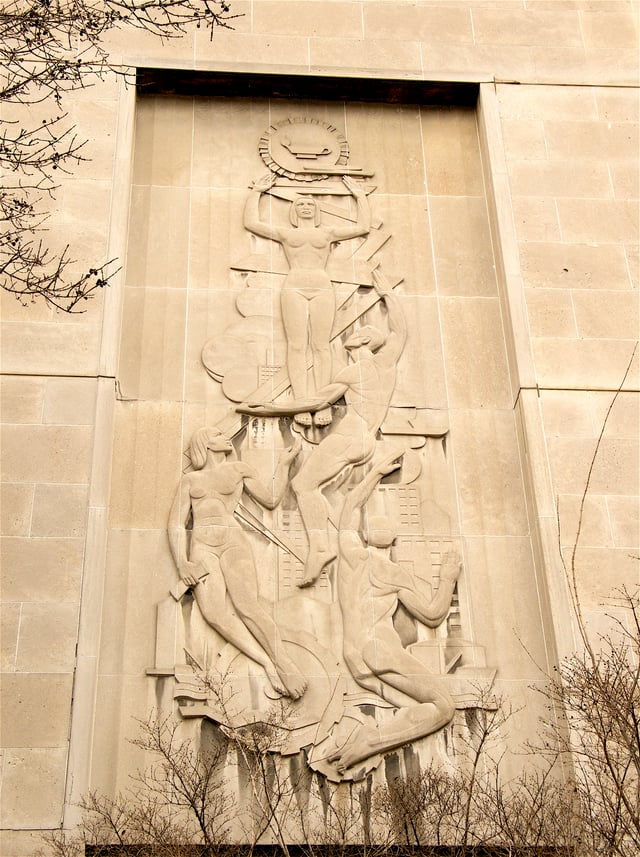
Elizabeth Wyn Wood's Bas-relief at Ryerson University in Toronto
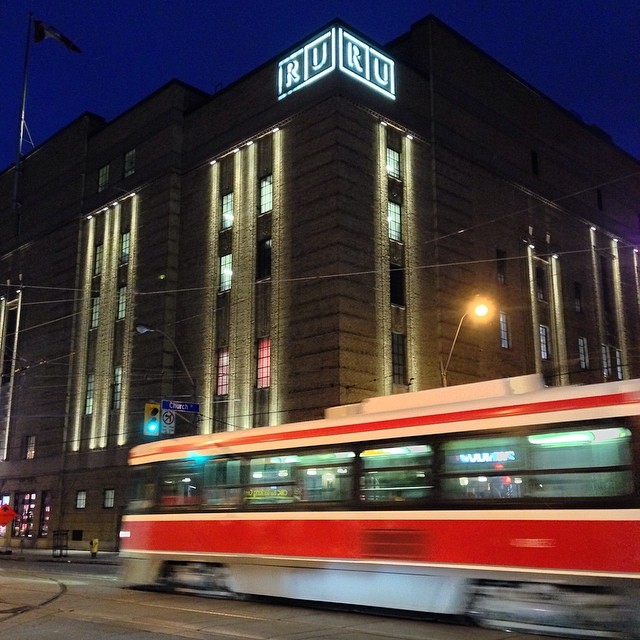
Ryerson logo on Maple Leaf Gardens
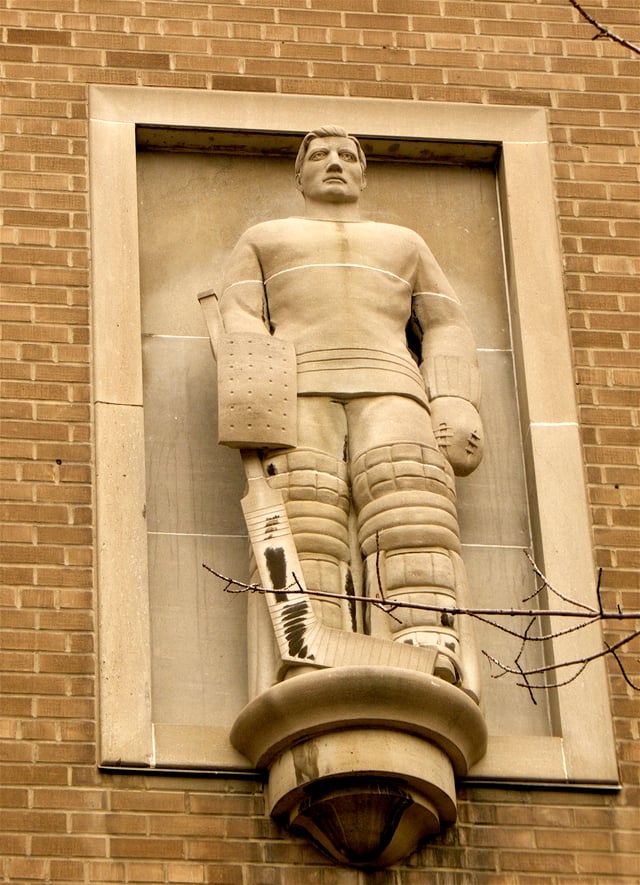
Elizabeth Wyn Wood's high relief of a goalie at Ryerson University in Toronto
University President Sheldon Levy announced December 1, 2009, that the school would acquire and renovate the Maple Leaf Gardens for use as a university athletic facility, at an estimated cost of $60 million. The cost was split three ways between the Canadian federal government, Ryerson University, and Loblaws.[7][67] Known as the Mattamy Athletic Centre, the facility includes sports venues and classrooms on upper levels. The street and lower levels feature a Loblaws supermarket, a Joe Fresh store, an LCBO store, and parking. Ryerson and Loblaws each own their space.[68]
The Mattamy Athletic Centre (commonly known as the "MAC") has full size basketball and volleyball courts, the Mattamy Home Ice (NHL sized skating rink), a cardio room, fitness centre with dumbbells and additional fitness machines.[69]
Library
The Ryerson Library collection consists of over 500,000 books, 3,700 print journal titles and over $2 million of electronic resources, including approximately 23,000 e-journals, approximately over 90,000 e-books, databases and indexes, geospatial data, and catalogued websites or electronic documents. Most of the electronic resources can be accessed remotely by Ryerson community members with internet access, although authentication of Ryerson Library registration is required for access to all commercial resources. The library acquires materials to support the curriculum taught at the university and to support the research needs of faculty. All hard copy materials are housed in the library building at Gould and Victoria Streets.
The 11-storey tower was built in 1974, and is a classic example of Brutalist architecture. The library buildings also hold an administrative office, the Nursing Collaborative, and, until 2007, the urban and Regional Planning program, when it moved to another facility increasing available space for the library additional.
As part of the Ryerson University Master Plan, the library is expected to either relocate or undergo extensive renovations in the next several years. To improve study space, the entire fourth floor of the library underwent construction during the 2008 academic year. The renovation included the addition of lounges, a graduate reading room, and LCD panels.[70] The second floor of the library is connected via bridge to the Student Learning Centre which opened in early 2015.[71]
Reputation and rankings
Ryerson is one of the most applied-to universities in Ontario relative to available spaces. In 2009, 2010, and 2011 (latest data available), the university ranked second in Ontario for first-choice applications from graduating high school students.[78] In the 2015-16 academic year, there were 69,382 undergraduate applications to Ryerson for 8,483 available spots.[79]
The University Business Incubator Index ranked Ryerson #1 in Canada and #3 in the world among more than 400 incubators in over 70 countries.[80]
The Globe and Mail's Canadian University Report 2013 classifies Ryerson as a Large University (over 22,000 students) where it was graded "A-" in the "Quality of Teaching and Learning" category.[83]
In 2017, Ryerson was ranked second on seekingarrangement.com's annual list of Fastest Growing Sugar Baby Schools in Canada.[85]
Chancellors
Honourable David Crombie 1994 – 1999
John Craig Eaton - 1999 – 2006
G. Raymond Chang 2006 – 2012
Lawrence Bloomberg 2012 – 2018
Janice Fukakusa 2018 – present
Principal
Howard Hillen Kerr 1948 –1966
Presidents
Frederick Jorgenson 1966 –1969
Anthony Wilkinson 1969 –1970
Donald Mordell 1970 –1974
George Korey 1974 –1975
Walter Pitman 1975 –1980
Brian Segal 1980 –1988
Terrence Wyly Grier 1988 –1990
Dennis Mock (acting Aug –Jan) 1990 –1991
Terrence Wyly Grier 1991 –1995
Claude Lajeunesse 1995 –2005
Sheldon Levy 2005 –2015
Mohamed Lachemi 2015 –Present
Faculty
In November 2005, Professor Arne Kislenko won TVOntario's first Best Lecturer Series. In 2006, Ryerson University had two professors in the semi-finals for TVO's second Best Lecturer Competition. Philosophy professor Dr. James Cunningham, and radio and television arts professor Dana Lee were semi-finalists. In 2006, Greg Inwood, professor in the department of Politics and Public Administration, was awarded the prestigious Donald Smiley Prize for his book Continentalizing Canada: The Politics and Legacy of the Macdonald Royal Commission. Criminal justice history and international relations professor Peter Vronsky published Serial Killers: The Method and Madness of Monsters (2004), a bestselling history of serial homicide, and more recently a controversial history of Canada's first modern battle, Ridgeway: The American Fenian Invasion and the 1866 Battle That Made Canada (2011).
Student life
| Undergraduate | Graduate | |
|---|---|---|
| Male | 46.1% | 49.5% |
| Female | 53.9% | 50.5% |
| Canadian student | 96.7% | 90.2% |
| International student | 3.3% | 9.8% |
Ryerson has 39,300 undergraduate students and 2,600 students in the masters and Ph.D programs.[5] Many of the students are from within the Greater Toronto Area, but it also draws students from other countries.[87] Ryerson is among the largest commuter schools in Canada, with upwards of 90 percent of all students commuting to campus.[88]
The university provides on-campus housing for 1417 students in three residence buildings located on the university campus: the International Living/Learning Centre (ILC) at 240 Jarvis St, Pitman Hall at 160 Mutual St, and the Daphne Cockwell Complex at 288 Church st.[89] Ryerson Housing & Residence Life also has a formal partnership with the HOEM Residence, a privately owned student residence located at 186 Jarvis St. HOEM is the largest residence on campus. The O'Keefe House at Bond and Gould streets was previously used as a student residence but was retired on the opening of the HOEM residence just off campus.
Student media at the university include campus radio station CJRU (succeeding CKLN-FM and CJRT-FM) and the student newspaper The Eyeopener. Students in the university's journalism program produce a second newspaper, The Ryersonian, and a biannual magazine, the Ryerson Review of Journalism. The newspaper "The Golden Ram" is produced by the Ryerson Engineering Student Society (RESS).
Ryerson officially does not allow Greek Life but "unofficially" has the following Greek Letter Organization affiliations:
Alpha Epsilon Pi fraternity (Pi Rho chapter)
Delta Phi Nu sorority (Sigma Tau chapter)[90]
Delta Pi sorority (Alpha chapter)
Delta Psi Delta sorority (Gamma chapter)
Phi Kappa Pi fraternity (Sigma Pi chapter)
Sigma Chi fraternity (Beta Omega chapter)
Sigma Pi fraternity (Eta Omicron chapter)
Noted alumni
Facilities
|
|
|
|
|
Beginning in the fall of 2008, Ryerson also uses the AMC (now Cineplex) facilities (in 10 Dundas East) during the day for lectures.
Associations
Association of Commonwealth Universities (ACU)
Association of Universities and Colleges of Canada (AUCC)
Association to Advance Collegiate Schools of Business (AACSB)
Continuing Education Students' Association of Ryerson (CESAR)
Council of Ontario Universities (COU)
Ryerson Students' Union (RSU)
Ryerson University Alumni Association (RUAA)[92]
See also
Higher education in Ontario
Canadian industrial research and development organizations
Canadian government scientific research organizations
Canadian university scientific research organizations
U Sports
Ontario Student Assistance Program
List of colleges and universities named after people
List of Ontario Universities
